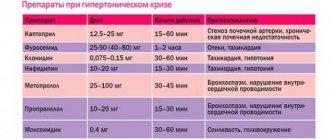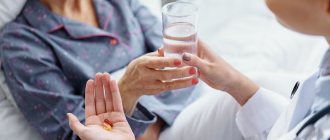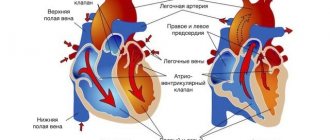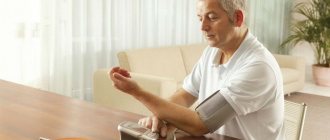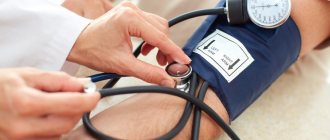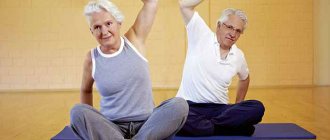Hypertensive crisis is an acute cerebrovascular accident associated with a sharp increase in blood pressure.
As a rule, the cause is hypertension. As practice shows, it was either not treated, or the treatment was incorrect. Very rarely, but an attack of hypertensive crisis occurs without previous symptoms of hypertension. Provoking factors: stress, overwork, heavy physical activity, stopping medications and refusing a diet with limited consumption of table salt, drinking alcohol, sudden changes in temperature (for example, in a bathhouse), etc.
Symptoms of a hypertensive crisis:
- increase in diastolic blood pressure above 110-120 mm Hg.
- sharp headache, usually in the back of the head
- sensation of pulsation in the temples
- shortness of breath (due to increased load on the left ventricle of the heart)
- nausea or vomiting
- visual impairment (flickering “fly spots” before the eyes), possible partial loss of visual fields
- redness of the skin
- possible occurrence of compressive pain behind the sternum
- excitement, irritability
First aid for hypertensive crisis
First of all, if you suspect a hypertensive crisis, you need to measure your blood pressure. It should be raised. Pressure is measured using a tonometer, which is usually found in the home of hypertensive patients. If you suspect a hypertensive crisis, immediately call an ambulance, because emergency hospitalization of the patient may be required (remember that the process develops quickly).
Sequence and principles of first aid:
- Call an ambulance
- Calm the person down (excitement only increases blood pressure);
- Put him in bed and give him a semi-sitting position;
- Make sure that the patient breathes evenly and deeply;
- Apply a cold heating pad or compress to your head;
- Provide access to oxygen (open the window, unbutton your clothes);
- Give an antihypertensive drug that the patient had previously taken or put a captopril tablet under the tongue (or Corinfar, Capoten, nifedipine, Cordaflex), if after half an hour there is no improvement, then you can take the drug from the list again, but, in general, not more than 2 times!
- Drip tincture of motherwort or valerian, Corvalol;
- To combat the feeling of cold and chills, cover the patient with warm heating pads;
- If chest pain occurs, you should take nitroglycerin.
If a nosebleed occurs, you need to pinch your nose for five minutes and apply a cold compress to the bridge of your nose (do not tilt your head back).
It is important to know that at the time of a hypertensive crisis, patients often experience a strong feeling of fear. This is due to a sharp release of stress hormones. And your task is not to show unnecessary concern about his condition through your actions or words, and not to panic. Talk calmly, kindly, reassuring the patient and telling him that this condition passes, it is not scary, and the doctor will certainly help.
It is important to remember that you can reduce blood pressure during a hypertensive crisis by no more than 10 mm Hg. per hour to avoid collapse. During the first 2 hours, blood pressure levels can be reduced by 20-25%.
After first aid is provided, medical personnel must act. If blood pressure does not decrease, and the patient’s condition worsens, chest pain and other suspicious symptoms develop, and you have not yet called a team of doctors, then urgently call an ambulance. You can't hesitate!
Measure your blood pressure every 20 minutes, the result will be important for emergency doctors
Sometimes, after receiving medical care, the patient feels better and hospitalization is not required. But in some cases, at the discretion of specialists, urgent treatment in a hospital is necessary, which should not be refused under any circumstances.
Keep in mind that a hypertensive crisis is fraught with various complications: cerebral hemorrhage (stroke), angina pectoris, myocardial infarction, pulmonary edema, etc.
Remember that the well-being of the further outcome of the disease depends on your first actions.
First aid for a heart attack
Characteristic signs (symptoms) of a heart attack (myocardial infarction):
• sudden (paroxysmal) pressing, squeezing, burning, aching pain in the chest (behind the sternum), lasting more than 5 minutes;
• similar pains are often observed in the left shoulder (forearm), left shoulder blade, left half of the neck and lower jaw, both shoulders, both arms, the lower part of the sternum along with the upper abdomen;
• lack of air, shortness of breath, severe weakness, cold sweat, nausea often occur together, sometimes following or preceding discomfort/pain in the chest;
• it is not uncommon for these manifestations of the disease to develop against the background of physical or psycho-emotional stress, but more often with some interval after them.
Uncharacteristic signs that are often confused with a heart attack:
• stabbing, cutting, pulsating, drilling, constant aching pain for many hours and not changing its intensity in the heart area or in a specific clearly defined area of the chest.
Algorithm for emergency actions in case of a heart attack (advice to the patient)
If you or someone else suddenly has the above characteristic signs of a heart attack, even with weak or moderate intensity, which last more than 5 minutes, do not hesitate, immediately call an ambulance team. Do not wait more than 10 minutes - in such a situation it is life-threatening.
Remember that being intoxicated in this deadly situation is not a reasonable excuse for delaying calling an ambulance!
If you have symptoms of a heart attack and there is no way to call an ambulance, then ask someone to take you to the hospital - this is the only right decision. Never drive yourself unless you have no other choice.
In the most optimal scenario, if a heart attack occurs, you must follow the instructions received from your attending physician; if there are no such instructions, then you must act according to the following algorithm:
• Immediately after an attack occurs, sit down (preferably in a chair with armrests) or lie in bed with the head of the bed raised, take 0.25 g of acetylsalicylic acid (aspirin) (chew the tablet, swallow) and 0.5 mg of nitroglycerin (spray one inhalation dose into the cavity mouth while holding your breath, place one tablet/capsule under the tongue, first bite the capsule, do not swallow); free your neck and provide fresh air (open the vents or windows).
• If pain persists 5-7 minutes after taking acetylsalicylic acid (aspirin) and nitroglycerin, it is imperative (life-saving) to call an ambulance and take nitroglycerin a second time.
• If pain persists 10 minutes after taking the second dose of nitroglycerin, it is necessary to take nitroglycerin a third time.
• If after the first or subsequent doses of nitroglycerin there is severe weakness, sweating, shortness of breath, you need to lie down, raise your legs (on a bolster, etc.), drink 1 glass of water and then, as with a severe headache, do not take nitroglycerin.
• If the patient has previously taken drugs that lower blood cholesterol from the statin group (simvastatin, lovastatin, fluvastatin, pravastatin, atorvastatin, rosuvastatin), give the patient his usual daily dose and take the drug with you to the hospital.
Attention!
A patient with a heart attack is strictly forbidden to get up, walk, smoke or eat until the doctor’s special permission;
You should not take aspirin
(acetylsalicylic acid) if you are intolerant to it (allergic reactions), as well as if there is a clear exacerbation of gastric and duodenal ulcers;
Nitroglycerin should not be taken
if there is severe weakness, sweating, or if there is severe headache, dizziness, or acute impairment of vision, speech, or coordination of movements.
Prevention
- Every hypertensive patient should be informed about what causes can lead to a hypertensive crisis.
- Strictly follow all necessary medications prescribed by your doctor. Negligence in taking vital medications often causes a crisis.
- Follow a diet. Excessive consumption of salty foods leads to fluid retention in the body and, consequently, increased blood pressure. Fatty, fried foods cause the formation of cholesterol plaques. The latter, in turn, clog blood vessels and contribute to increased blood pressure.
- Hypertensive patients are strictly not recommended to drink alcoholic beverages, which excite the nervous system and cause vasoconstriction.
- Take medications regularly to normalize blood pressure.
- Eliminate caffeine-containing drinks from your diet.
- Completely get rid of bad habits.
- From time to time, take a course of therapeutic massage.
- Take sedative medications regularly.
Patients suffering from hypertension are advised to regularly monitor their blood pressure, promptly replenish their own first aid kit with the necessary medications, and if the above-described symptoms occur, immediately seek medical help.
Maintaining a healthy lifestyle, giving up bad habits, proper, rational nutrition and sports are the reasons for a person’s external and internal health. Any disease can be prevented if you take timely care of your own condition. Following these simple recommendations allows hypertensive patients to keep their blood pressure under control and enjoy a full life.
First aid for sudden death (tips for eyewitnesses)
Most often, sudden death occurs due to cessation of cardiac activity.
The main signs (symptoms) of sudden death:
• Sudden loss of consciousness, often accompanied by agonal movements (a standing or sitting person falls, convulsive muscle tension, involuntary urination and defecation are often observed; a lying person sometimes makes a convulsive attempt to sit up or turn on his side).
• Sudden complete cessation of breathing, often after a short period (5-10 seconds) of agonal pseudobreathing: the patient makes wheezing and/or gurgling sounds, sometimes similar to a convulsive attempt to say something.
How to provide first aid?
Every experienced hypertensive patient, as a rule, is well aware of his disease and has medications at home that he uses to relieve a hypertensive crisis. First aid can be provided by administering drugs intramuscularly, which will relieve the symptoms of high blood pressure.
It is worth considering that this practice is used only for uncomplicated first-degree hypertensive crisis. These drugs include: “Furosemide”, “Dibazol”, “Magnesia sulfate”, “Anspasmodics”, “No-shpa” and “Papaverine”.
Often, during a first-degree hypertensive crisis, intramuscular administration of these drugs completely relieves the symptoms of the attack and normalizes the patient’s blood pressure.
It is impossible to predict the occurrence of pathology. This can happen at home, at work, in a restaurant, on the street. It is very important that a hypertensive crisis be eliminated quickly, so emergency care must be provided promptly, the algorithm is described below.
